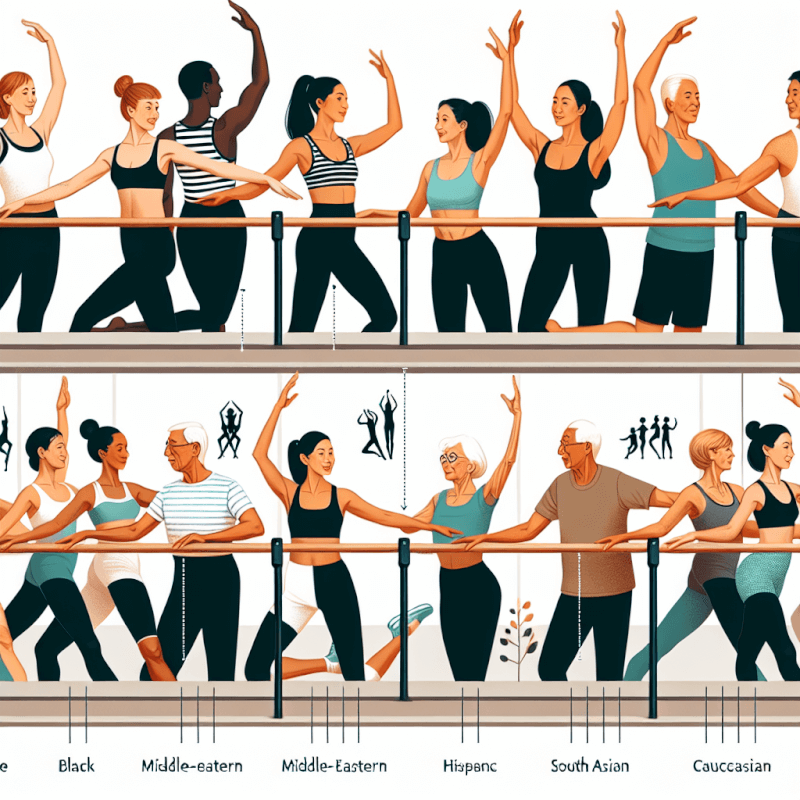Are you over 50 and looking for an effective workout that will tone your muscles, improve your balance, and boost your overall fitness? Look no further than the barre workout! Designed specifically for individuals in their golden years, this low-impact exercise regimen combines elements of ballet, Pilates, and yoga to create a challenging yet accessible routine. By incorporating gentle movements and light weights, the barre workout aims to strengthen your core, increase flexibility, and enhance your posture. So, put on your workout clothes and join us as we explore the incredible benefits of the barre workout for those over 50. Get ready to feel stronger, more balanced, and rejuvenated!

Benefits of Barre Workout for Over 50
Improved Strength
One of the major benefits of a barre workout for individuals over 50 is improved strength. As we age, our muscles naturally start to weaken and lose mass. However, engaging in regular barre exercises can help counteract this process. Barre workouts target specific muscle groups, such as the arms, legs, and core, through a series of isometric and isotonic movements. These low-impact exercises focus on building endurance and strength, helping to tone and strengthen muscles that may have grown weaker over time.
Increased Flexibility and Balance
Maintaining flexibility and balance becomes increasingly crucial as we age to prevent injuries and navigate daily activities with ease. Barre workouts incorporate a variety of dynamic stretching and lengthening movements, helping to improve flexibility and increase range of motion. Furthermore, the careful attention to alignment and posture during barre exercises can greatly enhance balance and stability, reducing the risk of falls and accidents.
Enhanced Joint Health
As we grow older, joint health becomes a significant concern. The low-impact nature of barre workouts makes them an excellent choice for individuals with joint issues or arthritis. By engaging in controlled movements and avoiding high-impact exercises, barre workouts help in strengthening the muscles around the joints, providing support and reducing strain. The fluid and controlled movements in a barre workout also help to lubricate the joints, promoting their overall health and longevity.
Boosted Energy Levels
Feeling sluggish or fatigued is a common complaint among older individuals. However, incorporating a barre workout into your routine can help boost energy levels. The combination of gentle cardiovascular exercises and targeted muscle work increases blood flow, delivering oxygen and essential nutrients throughout the body. This enhanced circulation can leave you feeling energized and revitalized both during and after the workout.
Weight Management
Maintaining a healthy weight is essential for overall wellbeing and preventing chronic diseases. Barre workouts offer a unique blend of cardiovascular exercise and strength training, making them an effective tool for weight management. By raising the heart rate and increasing calorie burn, barre workouts can help in shedding excess pounds. Additionally, building lean muscle mass through regular barre exercises can boost metabolism, promoting long-term weight maintenance.
Reduced Risk of Chronic Diseases
Regular physical activity is known to reduce the risk of chronic diseases, such as heart disease, diabetes, and certain types of cancer. Engaging in a barre workout on a consistent basis can contribute to minimizing this risk. By improving cardiovascular health, enhancing muscular strength, and maintaining a healthy weight, barre workouts can help prevent or manage these common health conditions that often become more prevalent with age.
Preparing for a Barre Workout
Consulting with a Healthcare Professional
Before starting any new exercise regimen, it is always a good idea to consult with a healthcare professional, especially if you have any pre-existing health conditions or concerns. They can provide personalized advice and guidance to ensure that a barre workout is safe and appropriate for your individual needs.
Finding the Right Class
Finding the right barre class is crucial for a successful workout experience. Look for classes specifically tailored for individuals over 50, as these classes may offer modifications and variations that cater to a more mature audience. Consider factors such as the instructor’s qualifications and experience, class size, and the overall atmosphere of the studio. Trying out a few different classes and instructors can help you find the perfect fit for your preferences and goals.
Wearing Appropriate Attire
Choosing the right attire for a barre workout can greatly enhance your comfort and performance. Opt for form-fitting, breathable clothing that allows for a full range of motion. Avoid loose or baggy clothing that may impede movement or get caught on equipment. Additionally, investing in a pair of grip socks can provide extra stability and prevent slipping during exercises.
Gathering Necessary Equipment
Barre workouts typically require minimal equipment, but it’s important to have the essentials on hand. A sturdy chair or barre can be used for support during certain exercises, and a mat can provide cushioning and support for floor exercises. Additionally, having a set of light hand weights or resistance bands may be beneficial for added resistance and variety in your workout routine.

Warm-Up Exercises
Before diving into the main barre workout, it is essential to properly warm up your muscles and increase blood flow. The warm-up phase prepares your body for the more challenging exercises to come and reduces the risk of injury. Here are some common warm-up exercises often incorporated into barre workouts:
Neck Rolls
Begin by gently rolling your neck in a circular motion, starting from one shoulder and proceeding to the other. This exercise relaxes the neck muscles and releases tension.
Arm Circles
Stand with your feet hip-width apart and extend your arms out to the sides at shoulder height. Make small circles with your arms, gradually increasing the size of the circles. This exercise helps to warm up the shoulder joints and improve range of motion.
Shoulder Shrugs
Stand with your feet hip-width apart and relax your arms by your sides. Shrug your shoulders up towards your ears, hold for a moment, and then release. Repeat this movement several times to release tension in the shoulders.
Toe Touches
Stand with your feet hip-width apart and slowly bend forward, reaching your hands towards your toes. If you’re unable to touch your toes, simply reach as far as is comfortable for you. This exercise stretches the hamstrings and helps to warm up the lower back.
Standing Hip Circles
Stand with your feet hip-width apart and place your hands on your hips. Circle your hips in a clockwise direction, gradually increasing the size of the circles. Repeat in a counterclockwise direction. This exercise helps to loosen the hip joints and increase mobility.
Main Barre Workout Routine
The main barre workout routine consists of a series of exercises that target different muscle groups and provide a full-body workout. These exercises utilize various ballet-inspired movements and techniques to sculpt and tone the body. Here are some common exercises you may encounter during a barre workout:
Plies
Start by standing with your feet wider than hip-width apart and toes turned out. Bend your knees, keeping them in line with your toes, and then straighten your legs, squeezing your glutes at the top. Plies primarily work the inner and outer thighs, as well as the quadriceps and glutes.
Lunges
Step forward with one foot, keeping your front knee directly above your ankle and your back knee bent. Press through your front heel to return to the starting position, and then repeat on the other side. Lunges target the quadriceps, hamstrings, glutes, and calves.
Squats
Stand with your feet hip-width apart and toes pointed slightly outward. Bend your knees, lowering your hips as if you were sitting back into a chair, and then return to standing. Squats mainly engage the quads, hamstrings, glutes, and calves.
Leg Lifts
Stand facing a barre or chair for support. Lift one leg straight out in front of you as high as possible, while keeping the rest of your body stable. Lower your leg back down and repeat on the other side. Leg lifts are excellent for targeting the glutes, hamstrings, and hip flexors.
Pulses
Pulses involve small, controlled movements performed in a specific range of motion. For example, you may perform small, pulsing squats or pulsing leg lifts to intensify the muscle engagement and promote muscle endurance.
Side Leg Raises
Stand facing a barre or chair for support. Lift one leg out to the side as high as possible without leaning your body. Lower your leg back down and repeat on the other side. Side leg raises primarily work the outer thighs, glutes, and hip abductor muscles.
Bicep Curls
Hold a set of light hand weights in each hand, with your palms facing forward. Keep your elbows close to your sides and slowly bend your arms, bringing the weights towards your shoulders. Lower the weights back down and repeat. Bicep curls target the biceps and forearms.
Tricep Dips
Sit on the edge of a sturdy chair, with your hands gripping the front edge, fingers facing forward. Slide your bottom off the chair, keeping your feet flat on the floor. Lower your body down, bending your elbows, and then push back up to the starting position. Tricep dips engage and strengthen the triceps and shoulders.
Modified Push-Ups
Assume a traditional push-up position, but instead of being on your toes, rest your knees on the ground. Lower your chest towards the floor while keeping your core engaged and your elbows close to your body. Push yourself back up and repeat. Modified push-ups target the chest, shoulders, and triceps.
Core Strengthening Exercises
Barre workouts often include specific exercises to target the core muscles, including the abdominals and the muscles that support the spine. These exercises typically involve slow, controlled movements that engage the deep core muscles, such as planks, abdominal crunches, and pelvic tilts.

Modifying Barre Exercises for Safety
While barre workouts are generally safe for individuals of all fitness levels, it is important to listen to your body and make modifications as needed. Here are some ways to modify barre exercises to ensure safety:
Using a Chair or Barre for Support
If balance is a concern, using a chair or barre for support can help stabilize yourself during exercises. Place one hand on the back of a sturdy chair or grip the barre lightly to ensure proper balance and stability.
Reducing Range of Motion
If certain movements cause discomfort or are beyond your current range of motion, it is perfectly fine to reduce the range of motion or range of movement. For example, if squatting deeply is challenging, simply perform smaller, more controlled squats until you build more strength and flexibility.
Avoiding Overexertion
Pushing yourself during a workout is important for progress, but it is also crucial to avoid pushing yourself too hard. Overexertion can lead to injuries or excessive muscle soreness. Always listen to your body and take breaks when needed. It’s better to gradually build strength and endurance rather than trying to do too much too soon.
Listening to Your Body
Your body is unique, and what works for others may not work for you. Pay close attention to how your body feels during and after the workout. If you experience pain or discomfort that is more than just muscle fatigue, modify the exercises or consult with a healthcare professional to ensure you are engaging in safe and appropriate workouts.
Incorporating Barre into a Well-Rounded Fitness Routine
Combining Barre with Cardiovascular Exercise
While barre workouts provide cardiovascular benefits, it is still important to include dedicated cardiovascular exercises into your fitness routine. Consider adding activities such as brisk walking, swimming, cycling, or dancing to your weekly schedule to further improve cardiovascular health and increase calorie burn.
Including Strength Training
While barre workouts already include strength training elements, adding additional strength training exercises can help further build muscle mass, increase bone density, and boost metabolism. Incorporate exercises using resistance bands, free weights, or weight machines to target all major muscle groups.
Adding Rest and Recovery Days
Rest and recovery are essential components of any fitness routine, regardless of age. Make sure to incorporate rest days into your weekly schedule to allow your body time to repair and rebuild. Listen to your body and give yourself permission to take breaks when needed.
Maintaining a Balanced Diet
Exercise is just one piece of the puzzle when it comes to overall wellbeing. A balanced diet, rich in nutrient-dense foods, is crucial for optimal health. Focus on incorporating a variety of fruits, vegetables, whole grains, lean proteins, and healthy fats into your daily meals. Stay hydrated by drinking plenty of water, and avoid excessive consumption of sugary and processed foods.

Tips for Barre Success
Consistency is Key
Consistency is essential when it comes to seeing progress and reaping the benefits of a barre workout. Aim for regular workouts, ideally at least three to four times a week. Even if you can only dedicate a short amount of time each day, staying consistent with your practice will yield better results than sporadic, intense workouts.
Starting Slowly and Progressing Gradually
If you’re new to barre or returning to exercise after a period of inactivity, it’s important to start slowly and gradually increase the intensity and duration of your workouts. Begin with shorter sessions and slowly build up to longer durations as you improve your strength and endurance. Additionally, focus on mastering proper form and technique before progressing to more challenging exercises.
Seeking Professional Guidance if Needed
If you’re unsure about proper form, technique, or modifications, don’t hesitate to seek professional guidance. Consider working with a certified barre instructor who can provide personalized guidance and ensure that you are performing exercises correctly and safely. They can also offer modifications specific to your needs and abilities.
Listening to Instructor Cues
When attending a barre class or following an instructional video, listen carefully to the cues provided by the instructor. They will guide you through proper form and alignment, offer modifications when necessary, and provide helpful tips for maximizing the effectiveness of each exercise.
Practicing Proper Form and Alignment
Proper form and alignment are paramount in any exercise routine to prevent injuries and maximize results. Focus on maintaining a neutral spine, engaging your core, and keeping your joints properly aligned throughout each exercise. Avoid overarching your back, hunching your shoulders, or locking your joints.
Staying Hydrated
Proper hydration is crucial for optimal performance and recovery. Drink water before, during, and after your barre workouts to replenish fluids lost through sweating. Sip water regularly throughout the day to ensure adequate hydration.
Listening to Your Body’s Limits
Your body is unique, and it’s important to listen to its signals. If you experience extreme fatigue, dizziness, or pain during a workout, it’s important to listen to your body and take a break or modify the exercise. Pushing through discomfort can lead to injuries or setbacks in your fitness journey.
Common Barre Mistakes to Avoid
Overexerting Yourself
One common mistake is pushing yourself too hard and trying to do too much too soon. Gradually increase intensity and difficulty over time to give your body a chance to adapt and avoid overexertion.
Ignoring Proper Alignment
Proper alignment is crucial for effective and safe barre workouts. Ignoring proper form and alignment can lead to injuries and prevent you from effectively targeting the intended muscles. Focus on maintaining proper posture and alignment throughout each exercise.
Neglecting Warm-Up and Cool-Down
Skipping the warm-up and cool-down portions of a barre workout is a common mistake that can lead to injuries and increased muscle soreness. Dedicate time to properly warm up your muscles before each workout and cool down and stretch afterward to promote flexibility and aid in recovery.
Skipping Modifications
Ignoring modifications and trying to perform exercises beyond your current capabilities can be detrimental to your progress and potentially lead to injuries. Embrace modifications and cater your workouts to your individual needs and abilities.

Overcoming Barre Workout Challenges
Dealing with Muscle Soreness
Muscle soreness is a common challenge when starting a new exercise routine, including barre workouts. To alleviate muscle soreness, incorporate light stretching, foam rolling, or even a gentle walk on rest days. Ensure you’re fueling your body properly with a balanced diet and getting adequate rest to aid in recovery and repair.
Adjusting to New Movements
If you’re new to barre or have never done ballet-inspired exercises before, adjusting to the new movements may take some time. Trust the process and be patient with yourself. As you continue to practice, your body will adapt, and the movements will become more familiar and fluid.
Building Stamina and Endurance
Building stamina and endurance is a process that takes time and consistent effort. Start with shorter workout durations and gradually increase the length and intensity of your workouts. Focus on building strength and cardiovascular fitness simultaneously to improve your overall endurance.
Conclusion
Barre workouts offer numerous benefits for individuals over 50, including improved strength, increased flexibility and balance, enhanced joint health, boosted energy levels, weight management, and reduced risk of chronic diseases. By preparing adequately, modifying exercises as necessary, and incorporating barre into a well-rounded fitness routine, individuals can experience the full potential of this valuable workout. Embrace the benefits, make necessary modifications, and maintain an active and healthy lifestyle to enjoy a fit and fulfilling life at any age.


